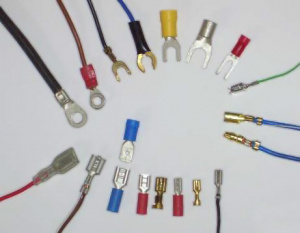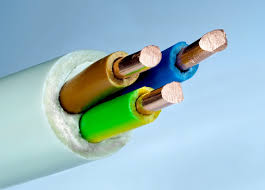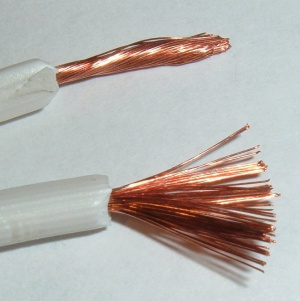Crimping
Contents
Introduction
According to Wikipedia, "Crimping is joining 2 pieces of metal or other ductile material (usually a wire and a metal plate) by deforming one or both of them to hold the other. The bend or deformity is called the crimp."
Crimping is a good replacement to solder terminations. It provides a very good quality connection between a wire and a terminal at a comparatively low cost. Which method to use for applying crimp terminations depends on the application and volume. The methods range from handheld devices to fully automated systems. [1]
If we don't have a good understanding of the crimping process, and the factors that can affect it, the result may not be satisfactory. [2]
The three key elements in the crimping process are the terminal, the wire, and the tooling.
Terminal

For quite a number of applications, it is economically impractical for connector manufacturers to design terminals to accept a single wire size, a single wire stranding, and a single insulation diameter (UL type) as well as Mil Specification ( United States defense standard, often called a military standard). Most terminals accommodate many wire sizes, stranding, and a range of insulation diameters, and the terminals are designed to meet acceptable levels over this entire range. [3]
Wire
The wire insulation type and stranding can vary a lot within one wire size. Wire strands can be made of copper, can be tinned, over coated, or top coated. Wire insulation thickness, materials and diameters are different for different applications. [4]
Additional Information AWG - American Wire Gauge is a standardized wire gauge system used since 1857 predominantly in North America for the diameters of round, solid, nonferrous, electrically conducting wire. [5]
Wires are of two types: [6]
- Solid: Solid conductors consist of a single strand of metal. It is easy to terminate these than stranded conductors. These wires are also mechanically tough. They are inexpensive. However, they have a major disadvantage: Lack of flexibility.
- Stranded: Stranded conductors consist of multiple metal strands bunched together in any number of configurations. They overcome the drawback of solid conductors because they are much more flexible. The higher the strand count, the more is the flexibility of the wire. While this can increase the cost, it is quite necessary for any wire or cable that will need to withstand any kind of flexing, or any other movement.
A finely stranded wire improves crimped joint performance. A wire made up of a few larger sized strands will tend to act as a solid wire. There are some stranded wire crimp configurations which are unsatisfactory for solid wire. More deformation are essential to be imposed in order to form wire and barrel into a solid mass. Finer strands, on the other hand, will more readily fill the inside corners of the crimp shape and more evenly distribute the forces of the crimp. [4]


Procedure[3]
Prepare the Wire
- Check if any strands of the stranded wire have loosened and spread out to be larger than the wire and the insulation together. In case this has happened, twist the wires to the size they were before stripping.
- The cut should be nice and clean. Check the insulation to ensure that. Don't use wires with damaged insulation.
- Ensure that the stripping tool has not cut/nicked any wire. If you see any nicked wires, you must cut and re-strip the wire before crimping. This ensure that there is no reduction in the amount of current that can be carried.
Setup and Operate a Hand Crimp Tool
- Ensure that you have the correct crimp tool. Check if it is designed for your specifications of size and terminal by looking in the Hand Crimp Tool Specification sheet.
- If the above check is passed, place the terminal in the tool.
- If you are using a locator, lift the locator and insert the terminal in the proper nest with the barrel up and against the locator bar. Release the locator blade to hold the terminal in position.
- Insert the wire.
- Squeeze the handle.
- Inspect for proper crimp location.
Importance of Proper Crimping [4]
Proper attachment of terminal to the wire is critical. Mechanical as well as electrical connections are important - The result of a properly crimped joint is a reliable mechanical and electrical connection.
The mechanical connection refers to the crimping of the terminal to the conductor. It must be so secure that it does not vibrate loose or be pulled off through normal use.
The electrical characteristics are equally important. The amount of electrical resistance caused by the crimp is a major concern, because it determines the ability of the crimp joint to conduct current.
One indication of the importance of proper crimping is evidenced in a study for the Space Shuttle Program that traced 28% of all defects to improperly assembled wiring and connectors.[4]
Tips for Crimping [7]
Step 1: Choosing the Wire
You may or may not have a say in deciding which wire to use, depending on your application. Avoid solid cored wire!
Step 2: Determine the wire size
The wire size may be listed in several ways. AWG (American Wire Gauge)(e.g. 16 AWG) is the most common. Otherways are listing the cross sectional area in square millimeters (e.g. 1 sq mm) or strand and diameter count (e.g. 32/0.2).
If you are buying a new wire, its size will be listed on the reel or packet.
These days, many wires have this information printed in the insulation, and repeated along the length. If you use standard wires, then insulation diameter should not give you a significant issue. In other cases, it is very crucial for the most reliable crimps as it affects how the rear of the crimp grips the wire.
Step 3: Choosing the Crimp Terminal
The terminal must have sufficient cross section size and conductive material that it is as good as an electrical conductor
The surfaces of the terminal and wire that are pressed into contact must be clean. They should be free of heavy, non-conductive films such as oxides, sulfides, and similar substances
Step 4: The Crimping Process
See https://www.robotshop.com/blog/en/how-to-crimp-connectors-4225.
You can also watch a video tutorial here: https://www.youtube.com/watch?v=kjSGCSwNuAg
Pre-Insulated Terminals [7]
If you are using pre-insulated terminals, you can tell the wire size by looking at the color.
The generally adopted standard is:
- Red Insulation: 0.5-1.5mm2 / 22-16 AWG
- Blue Insulation: 1.5-2.5mm2 / 16-14 AWG
- Yellow Insulation: 4.0-6.0mm2 / 12-10 AWG
There are other colours around, but you are not likely to come across these.
If you are done reading this page, you can go back to Mechanical Subsystem.
References
- ↑ https://www.shearwater.com/wp-content/uploads/2012/08/qual_crimp.pdf
- ↑ https://www.mouser.com/ds/2/276/TM-638000029-588559.pdf
- ↑ 3.0 3.1 https://www.rbracing-rsr.com/downloads/wiring_pdfs/crimp_molex.pdf
- ↑ 4.0 4.1 4.2 4.3 https://media.digikey.com/pdf/Data%20Sheets/Molex%20PDFs/Quality%20Crimp%20Handbook.pdf
- ↑ https://en.wikipedia.org/wiki/American_wire_gauge
- ↑ http://www.awcwire.com/conductor-stranding
- ↑ 7.0 7.1 http://www.instructables.com/id/How-to-Make-A-Quality-Crimped-Joint/